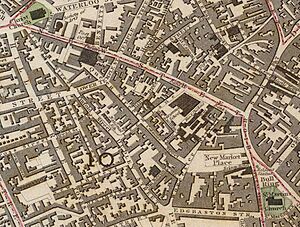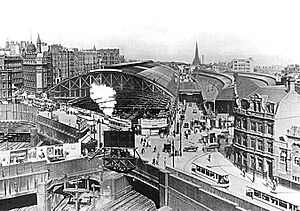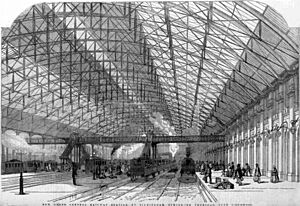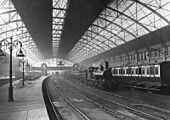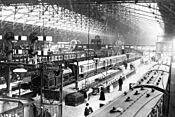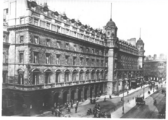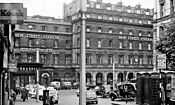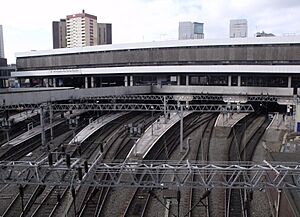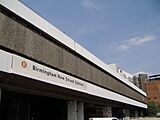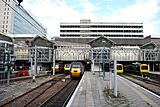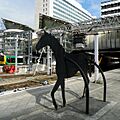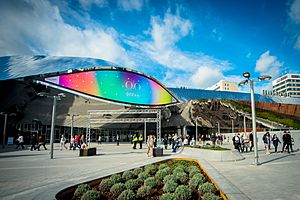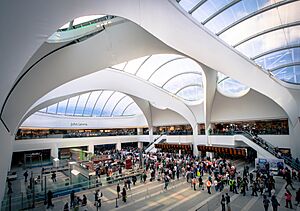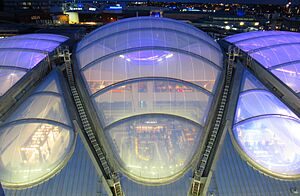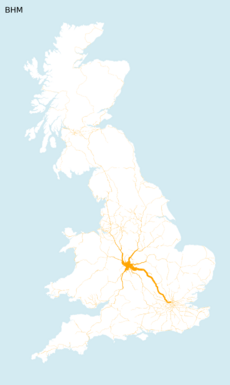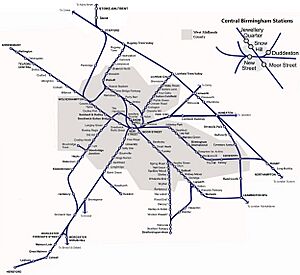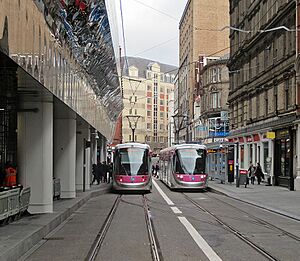Birmingham New Street railway station facts for kids
Quick facts for kids
|
|
|---|---|
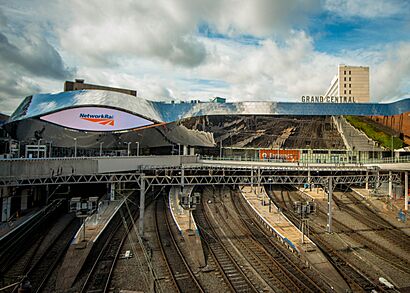
The east end of the station, with the newly rebuilt and refurbished building which opened in 2015.
|
|
| Location | Birmingham, West Midlands England |
| Coordinates | 52°28′40″N 1°53′56″W / 52.47777°N 1.89885°W |
| Platforms | 13 (including 4C) |
| Other information | |
| Station code | BHM |
| Fare zone | 1 |
| Classification | DfT category A |
| History | |
| Original company | London & North Western Railway |
| Key dates | |
| 1 June 1854 | First opened |
| 8 February 1885 | Extension opened |
| 1964–1967 | Rebuilt |
| 2010–2015 | Redeveloped |
| Traffic | |
| Passengers (2018/19) | |
| Passengers (2019/20) | |
| Passengers (2020/21) | |
| Passengers (2021/22) | |
| Passengers (2022/23) | |
Birmingham New Street, also known as New Street station, is a very important and busy railway station in Birmingham, England. It's the largest of the three main stations in the city centre and a key part of the British railway system. Many trains from places like London Euston, Glasgow Central, and Edinburgh Waverley arrive here. It's also a central point for the CrossCountry train network and local services around the West Midlands. The station's special code is BHM.
The station is named after New Street, a road that runs next to it. However, you can't enter the station directly from New Street, except through the Grand Central shopping centre. Today, you can enter the station from Stephenson Street, Smallbrook Queensway, Hill Street, and Navigation Street.
New Street is one of the busiest railway stations in the UK, and the busiest outside London. Between April 2022 and March 2023, over 30 million people entered or exited the station. It's also a major place for people to change trains, with over 4 million passengers doing so each year. In 2018, most passengers (92%) were happy with the station.
The first New Street station opened in 1854. It had the largest single-span arched roof in the world at the time! In the 1960s, the station was completely rebuilt. The new design, which had buildings covering most of it, became very crowded. So, between 2010 and 2015, the station had a huge £550 million makeover called Gateway Plus. This project gave it a new main hall (concourse), a modern outside look, and a new entrance on Stephenson Street.
Contents
History of Birmingham New Street
The First Stations
New Street station was built in central Birmingham by the London and North Western Railway (LNWR) between 1846 and 1854. It was built on a marshy area called "The Froggery." The new station replaced older ones, like Curzon Street, which were no longer big enough for all the trains.
The LNWR originally shared the station with the Midland Railway. But in 1885, the Midland Railway opened its own section next to the original station. This meant there were effectively two stations side-by-side, separated by a road called Queens Drive. Train traffic grew a lot. By 1900, New Street had about 40 trains arriving and departing every hour, and even more during busy times!
The Original LNWR Station
The LNWR decided to build a new station in the city centre in 1846. This meant buying land and knocking down about 70 houses. The station officially opened on 1 June 1854. However, parts of it were already in use two years earlier. On the opening day, the old Curzon Street station closed for regular passenger services, and trains from London started using New Street.
The station was designed by Edward Alfred Cowper. When it was finished, New Street had the largest arched iron and glass roof in the world! It was 211 feet (64 metres) wide and 840 feet (256 metres) long. It held this record for 14 years until St Pancras station opened in 1868. The famous architect George Gilbert Scott even praised New Street's roof.
The station had nine platforms. The main entrance building on Stephenson Street also included the Queens Hotel, which opened on the same day. The hotel was built in an Italian style and had 60 rooms. It grew bigger over the years.
Midland Railway Extension
The Midland Railway also used New Street from 1854. However, their trains often had to reverse direction, which was inconvenient. In 1885, a new railway link was built, allowing Midland trains to pass through New Street without reversing.
To handle more trains, the station needed to be bigger. Construction for the extension began in 1881. Many buildings were demolished to make space. The extension was built next to the original station and opened on 8 February 1885. It had four through platforms and one bay platform. After this, New Street nearly doubled in size, becoming one of Britain's largest stations, covering over 12 acres.
LMS and British Rail
In 1923, the LNWR and Midland Railway, along with other companies, joined to form the London, Midland and Scottish Railway (LMS). Then, in 1948, the railways were taken over by the government and became British Railways.
During World War II, the station's roof was badly damaged by bombs. After the war, the damaged roof was removed because it was too expensive to fix. Simple canopies were put over the platforms instead, until the station was rebuilt in the 1960s.
The 1960s Rebuild
The station was completely rebuilt in the 1960s as part of a big plan to modernise the West Coast Main Line. The old station and Queens Hotel were knocked down starting in 1964. The new New Street station opened on 6 March 1967. It cost £4.5 million to build.
The new station had twelve platforms. These platforms were covered by a huge concrete deck, which was supported by 200 columns. The main concourse and other buildings were built on top of this deck. Escalators, stairs, and lifts were added to help people get to the platforms.
A shopping centre, called the Pallasades Shopping Centre (now Grand Central), was built above the station between 1968 and 1970. There was also a nine-storey office block and a multi-storey car park. A 20-storey residential tower block, Stephenson Tower, was built next to the station. This tower was later demolished in 2012 as part of a new redevelopment.
In 1987, twelve horse sculptures by Kevin Atherton, called Iron Horse, were placed between New Street station and Wolverhampton. One of them is on platform 7 at New Street.
Because its platforms are underground, New Street was classed as an underground station by the fire service. In the 1990s, changes were made to meet stricter fire safety rules. A new footbridge was opened as a fire exit, which also became a public entrance to Navigation Street.
By the 2000s, many people didn't like the station. In 2007, only 52% of customers were happy with it. The station was designed for 60,000 passengers a day, but by 2008, it was handling over 120,000! This caused overcrowding. Also, the 1960s concrete design was often criticised for not looking good. In 2003, it was even called one of the biggest "eyesores" in the UK.
New Street Signal Box
The power signal box at New Street was finished in 1964. It's a Brutalist style building, which means it has a raw, concrete look. It's located next to the tracks near Navigation Street. This building is now a Grade II-listed building, meaning it's protected because of its special history or architecture.
The 2010–2015 Redevelopment
Because of the problems with the old station, plans to rebuild it started in the mid-2000s. Designs for a new Birmingham New Street Station, called Gateway Plus, were shown to the public in 2006. The plan was to completely rebuild the street-level parts of the station and improve the platforms.
In 2008, the government announced it would provide a lot of money for the project. Six architects were chosen to design the new station, and the design by Foreign Office Architects was picked.
The approved plans for the redevelopment included:
- A new main hall (concourse) that was three-and-a-half times bigger than the old one. It has a domed roof to let in natural light.
- Refurbished platforms with new escalators and lifts.
- A new station outside design and new entrances.
Some people worried that the new station wouldn't be big enough for the number of trains. However, work began on the redevelopment on 26 April 2010. The construction was done in stages to avoid too much disruption. One half of the new concourse opened in April 2013, and the old concourse closed. The complete new concourse opened on 20 September 2015. The shopping centre above, the Pallasades, was renamed Grand Central and also opened, including a John Lewis department store.
How the Station Works
About 80% of trains going to Birmingham pass through New Street. The other main city-centre stations are Birmingham Moor Street and Birmingham Snow Hill. Outside Birmingham, there's Birmingham International, which serves Birmingham Airport and the National Exhibition Centre.
Railway Operations
New Street is a central point for the West Midlands rail network and a major national hub. Network Rail manages the station and provides staff to help trains leave safely.
The station has twelve platforms. These are divided into 'a' and 'b' ends, which means they can handle more trains. There's also an extra platform called 4c. Longer trains might use the whole length of a platform.
All trains leaving New Street must be dispatched using special "Right Away" (RA) indicators. These signals tell the train driver it's safe to start the train, instead of using older hand signals.
There are also some sidings (short tracks) at the station where trains can wait. Some old tunnels are still there but are not used by passengers. One used to connect to a sorting office for mail, and another to the old Head Post Office.
All train signals are controlled by the West Midlands Signalling Centre in Saltley. The old New Street power signal box is still visible at street level on Navigation Street.
Approach Tunnels
All trains arriving and departing New Street must use one of several tunnels around the station:
- Stour Valley Line Tunnel: This tunnel goes west towards Wolverhampton. It's 927 yards (848 metres) long and opened in 1852.
- New Street South Tunnel: This tunnel is 254 yards (232 metres) long and goes east towards the Bullring shopping centre. It opened in 1854 and was made wider in 1896 to hold four tracks.
- Gloucester Line Tunnels: These are four tunnels in a row that go south-west towards Five Ways. They opened in 1885.
Customer Service
Network Rail runs a customer reception on the main concourse and helps people with mobility needs. Avanti West Coast operates the ticket office and barriers. Other train companies like CrossCountry also have staff to help passengers.
New Street is a "penalty fare" station for West Midlands Railway and London Northwestern Railway trains. This means if you don't have a valid ticket, you might have to pay a fine.
Train Operating Companies
Many different train companies use New Street. Currently, Avanti West Coast, CrossCountry, Transport for Wales, and West Midlands Trains provide services from the station.
Train Services
Here's a basic idea of how many trains leave New Street per hour during off-peak times (not rush hour):
- 2 trains per hour (tph) to Euston.
- 1 tph to Preston, with some trains continuing to Blackpool North, Edinburgh Waverley, or Glasgow Central.
- 2 tph to Manchester Piccadilly.
- 2 tph to Bristol Temple Meads, with some continuing to Plymouth, Penzance, or Paignton.
- 2 tph to Nottingham.
- 1 tph to Bournemouth.
- 2 tph to Leicester, with some continuing to Cambridge or Stansted Airport.
- 1 tph to Cardiff Central.
- 1 tph to Edinburgh Waverley, with some continuing to Glasgow Central or Aberdeen.
- 2 tph to Bromsgrove.
- 2 tph to Redditch.
- 2 tph to Four Oaks.
- 2 tph to Lichfield Trent Valley via Four Oaks.
- 2 tph to Wolverhampton.
- 2 tph to Walsall.
- 2 tph to Rugeley Trent Valley via Walsall.
- 2 tph to Birmingham International.
- 1 tph to Hereford.
- 2 tph to Shrewsbury.
- 2 tph to Euston.
- 1 tph to Liverpool Lime Street (2 tph on Saturdays).
Transport for Wales
- 1 tph to Birmingham International.
- 1 tph to Shrewsbury, continuing to Chester, Holyhead, Aberystwyth, or Pwllheli.
| Preceding station | Following station | |||
|---|---|---|---|---|
| Birmingham International | Transport for Wales Birmingham – Wales |
Sandwell & Dudley | ||
| Birmingham International | CrossCountry Bournemouth – Manchester |
Wolverhampton | ||
| Cheltenham Spa | CrossCountry Bristol – Manchester |
|||
| Leamington Spa | CrossCountry Reading – Newcastle |
Derby | ||
| Cheltenham Spa | CrossCountry Plymouth – Edinburgh |
Tamworth or Burton-on-Trent |
||
| University or Terminus |
CrossCountry Cardiff – Birmingham – Nottingham |
Wilnecote or Tamworth |
||
| Terminus | CrossCountry Birmingham – Leicester – Stansted Airport |
Water Orton or Coleshill Parkway |
||
| University | West Midlands Railway Hereford – Birmingham |
Terminus | ||
| Smethwick Galton Bridge | West Midlands Railway Shrewsbury – Birmingham |
Terminus | ||
| Terminus, Aston or Duddeston |
West Midlands Railway Cross-City Line |
Five Ways | ||
| Duddeston | West Midlands Railway Walsall – Aston – Birmingham – Wolverhampton |
Smethwick Rolfe Street | ||
| Birmingham International or Adderley Park | West Midlands Railway Birmingham – Walsall – Rugeley |
Tame Bridge Parkway | ||
| Adderley Park | West Midlands Railway Birmingham International – Birmingham New Street |
Terminus | ||
| Terminus | London Northwestern Railway Birmingham – Liverpool |
Smethwick Galton Bridge | ||
| Marston Green or Birmingham International |
London Northwestern Railway London – Birmingham |
Terminus | ||
| Birmingham International | Avanti West Coast London – Birmingham – North West & Scotland London – Shrewsbury |
Terminus, Sandwell & Dudley or Wolverhampton |
||
| Future services | ||||
| Moseley Village | West Midlands Railway Camp Hill line |
Terminus | ||
| Historical railways | ||||
| Monument Lane | London and North Western Railway Stour Valley Line |
Duddeston | ||
| London and North Western Railway Rugby–Birmingham–Stafford line |
Adderley Park | |||
| Terminus | London and North Western Railway Birmingham–Peterborough line |
Saltley | ||
| Five Ways | Midland Railway Birmingham West Suburban Railway |
Terminus | ||
| Camp Hill | Midland Railway Camp Hill line |
Terminus | ||
Getting Around Birmingham
West Midlands Metro
New Street station is connected to the West Midlands Metro tram system. The Grand Central tram stop is right outside the station's main entrance on Stephenson Street. This tram stop opened in May 2016. It connects New Street to Snow Hill station and further on to Wolverhampton.
Links to Other Stations
New Street station is about 600 metres (656 yards) from Birmingham Moor Street, which is the city's second busiest railway station. There's a clear path for passengers to walk between New Street and Moor Street, which goes through a bus tunnel under the Bullring shopping centre.
Birmingham Snow Hill station is about 1,000 metres (1,094 yards) away. You can walk there in about ten minutes, or take a short tram ride on the West Midlands Metro.
Station Incidents
- On 7 November 1850, a goods train derailed because of a gas explosion. No one was hurt, but part of the viaduct was damaged.
- On 26 November 1921, a serious accident happened when an express train crashed into a stationary train. Three people died, and twenty-four were injured. An investigation found that the express train had passed a danger signal.


